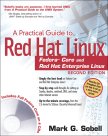
Fedora Core 3 and A Practical Guide to Red Hat Linux
A Practical Guide to Red Hat Linux, Second Edition: Fedora Core and Red Hat Enterprise Linux
describes Fedora Core 2.
Within the scope of this book, the changes to from Fedora Core 2 (FC2) to Fedora Core 3 (FC3) are minimal.
This page describes how to use this book with FC3.
Obtaining Fedora Core 3 CDs
Assuming you want to run FC3, you have several options:
You can download the appropriate ISO files and burn your own CDs (page 35).
The book explains how to download releases other than FC2.
Or you can purchase CDs on the Internet.
Following is a list of suppliers that sell FC3 CDs.
The list is for your convenience, none of these vendors is tried or recommended.
Make sure that you are satisfied with shipping charges and delivery times before you order.
linuxcdrs.com ($5.99 + $2.99 paypal)
EasyLinuxCDs.com ($5.99 + $5.00 USPS first class)
The Linux Emporium (UK: £8.00 + £2.00)
Maxtux (UK: £3.60 + £1.00)
Linux Pickup ($10.75 + $3.73)
Linux Central ($8.95 + $2.95 USPS first class / $4.85 USPS priority)
Linux CD (Europe: $7.96 + $4.20 priority mail [airmail])
123Linux.net ($4.95 + ?)
Release Notes
Please read the
release notes
before you install or upgrade to FC3.
The release notes contain a wealth of information.
You may not need most of it, but you may find one or two tidbits very useful as you install or start to run FC3.
Upgrade versus Install
If you are running FC2, you can either upgrade to FC3 or install FC3 as a new operating system.
An upgrade does not touch the old (modified) configuration files and extra packages; common components (RPM packages with the same name) of both the old and new systems are upgraded.
If you have modified a configuration file, an upgrade will leave it alone and install the new configuration file with a filename extension of .rpmnew.
A list of these files will be left in /root/upgrade.log.
You can use diff to see the differences between the new and old configuration files and use either one or a combination of the two.
As discussed on page 26, installing a fresh version of Fedora Core provides a more stable system than upgrading an existing system.
Although it may be possible to upgrade from FC2 to FC3 using yum or Apt, this method is not recommended. If you want to upgrade, proceed with installing FC3 and select the Upgrade option from the Upgrade Examine screen (Figure 3-1, page 48).
Installing Fedora Core 3
SELinux
The biggest difference between installing FC2 and FC3 is that SELinux (Security Enhanced Linux, pages 44 and 379) is turned on by default.
The default policy, called targeted policy, is new.
The targeted policy implements policies for the dhcpd, httpd, named, nscd, ntpd, portmap, snmpd, squid, and syslogd daemons.
See the
FC3 SELinux FAQ
for general information on SELinux under FC3 and
Targeted Policy
for information on the targeted policy.
Linux Journal
and
TECHWORLD
have stories about SELinux under FC3.
Once you have installed FC3, you can easily turn off SELinux by setting the SELINUX line in /etc/sysconfig/selinux to Disabled:
SELINUX=Disabled
Running Fedora Core 3
OpenSSH
OpenSSH (page 563) works a little differently in FC3.
First, an OpenSSH client (ssh, scp) will exit if permissions on and ownership of the ~/.ssh/config are not correct.
This file must be owned by the user who owns ~/ (your home directory).
That is, assuming that you own your home directory, and you should, you must own this file.
In addition, this file must have read/write permission for the owner and no permissions for anyone else (mode 600).
Use chown to change ownership and chmod to change permissions on a file.
Second, forwarding X11 (also called X11 tunneling) is turned off by default in FC3. It is turned on by default in FC2.
The section on Forwarding X11 on page 580 explains how to turn it on:
In order for X11 tunneling to work, you must enable it in both the server and the client.
On the server, set the X11Forwarding declaration to yes in /etc/ssh/sshd_config (page 578).
On the client, you can use the -X option to ssh on the command line or you can set the ForwardX11 declaration to yes in the ~/.ssh/config or /etc/ssh/ssh_config file (page 574).
In addition the behavior of tunneled clients invoked as described in the previous paragraph has changed:
Under FC3 (OpenSSH 3.8 and later) applications run as untrusted clients.
(Under FC2 they ran as trusted clients.)
Some applications may not work properly when run in this manner.
You can cause applications to run as trusted clients by using the -Y flag in place of the -X flag with ssh, or by setting the ForwardX11Trusted declaration to yes in the ~/.ssh/config or /etc/ssh/ssh_config file (page 574).
See the ssh_config man page for details.
udev
Whereas /dev used to be filled with all possible devices, udev provides a dynamic device directory that contains only devices that are present on a system.
It creates and removes device node files from the /dev directory.
For more information see
Udev on Fedora.
Other Changes
Refer to the
release notes
for a complete list of changes.
Links
Articles
OSNews: Fedora Core 3: A Short Review
Uche Ogbuji: Fedora Core 3: The upgrade from FC2
Places to Find Help
fedora-list:
Subscribe
Archives
LinuxQuestions.org
The Fedora Community Portal
Fedora Forum
Tips
Upgrading from Fedora Core 2 to Fedora Core 3 via Yum NOT TESTED
FC2 -> FC3 upgrade hint (Apt): compat-libstdc++ NOT TESTED
Google search on FC3 upgrade
Find a link that others might find useful? Send it to mgs@sobell.com.
